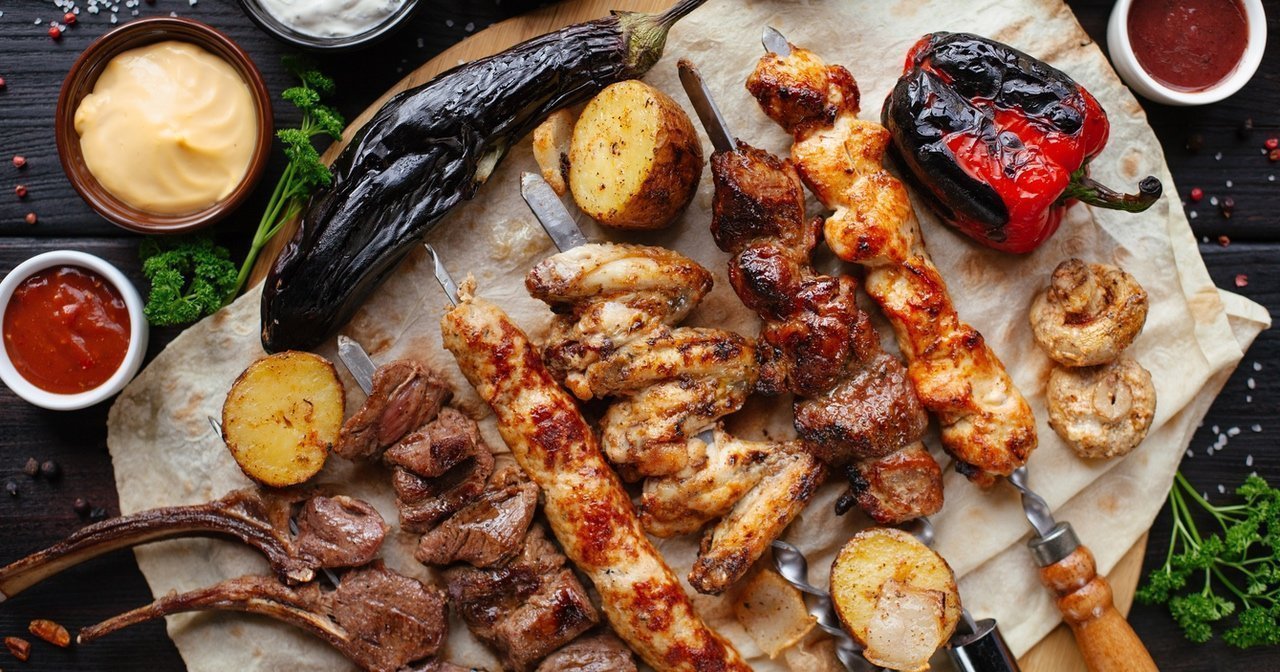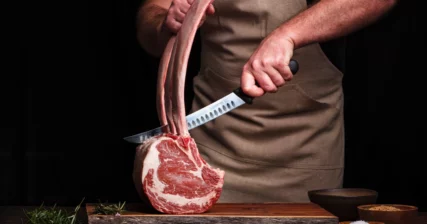Listen on: Apple Podcasts | Spotify
Which is the best diet for building a long-living, lean, fit body; low-carb, keto, low-fat, or high-protein?
If you’re looking for the short answer, it’s a high-protein diet.
Does that mean low-fat or low-carb diets never work? Not necessarily.
In this article, I’ll explain a little of the pros and cons of each diet. By the end, you should be able to see why a high-protein diet is the way to go for almost everyone.
Before getting to the diets, though, I need to address some basic nutrition science, and tackle the topic of why “calories in, calories out” isn’t as simple as your smartphone app would have you believe it to be.

Feel Better Fast. Guaranteed.
Energy+, EDGE, and MentaBiotics make up the Happy Juice supplement stack, with ingredients clinically proven to:
- decrease anxiousness scores by 55%
- decrease irritability scores by 60%
- decrease fatigue by 64%
- decrease anger 54%
- decrease tension by 45%
- decrease confusion by 43%
- decrease overall distress by 49%
- increase good bacteria by 70%
- decrease negative mood by 105%
- increase positive mood by 211%
Calories, Macronutrients, Basic Math
Obviously, the foods we eat contain calories. You see them posted on packages, restaurant menus, and alcohol bottles. When it’s not labeled, you can find it online.
We’ve grown to love the idea of counting calories because…well, we can count them. Not accurately, but we’ve been led to believe we can count them with a reasonable amount of accuracy.
We know that our love handles, saddle bags, and double chins are storage pouches of the calories we ate but didn’t need. And we believe that the way we get rid of them is to simply eat fewer calories.
To a certain extent, it does work.
When I was 15 years old, my ski jumping coach told me I needed to lose weight in order to be more competitive. I knew about calorie counts back then, so I decided to eat no more than 500 calories per day.
I filled up on diet pop and soda water, ate a few ounces of lunch meat each day and some vegetables, and once a week I went to the convenience store so I could splurge on salsa sandwiches.
Within a few months, I dropped my 5’10”, 154 lb frame down to 137 lbs.
I looked more like a meth addict than a ski jumper, but the scale said I did a good job with my diet.
Oh, in case you’re judging my parents, I lived in a dorm at Northern Michigan University, where they had an Olympic Training Center for ski jumping, for my junior year of high school. My parents were horrified the first time they saw me after my “successful” weight loss at a ski jumping tournament.
And herein lies one of the biggest problems about using only calories as a means of weight loss.
You lose as much muscle as you lose body fat.
And at an extreme, you can cause significant damage to your metabolism, such as diet-induced hypothyroidism.
The Flaws In Calories In, Calories Out
At an extreme, like my 500 calorie diet, you can lose weight. It’s a dumb way to do it, but it’s possible.
More often, though, people are encouraged to follow a long-term, chronically restricted diet to “slowly” lose weight.
This is just as bad as my asinine anorexic method. But, probably more frustrating because you live in constant deprivation, but don’t see any results from your efforts.
We’ve been sold the idea that weight loss and weight gain is just about calories for decades now. It goes something like this:
A pound of fat contains 3500 calories. Therefore, to lose a pound per week of body fat, you just need to eat 500 calories per day fewer than you burn.
In business, this is called spreadsheet math. Spreadsheet math doesn’t account for any variables outside of the simple formula put into the spreadsheet. Just as businesses don’t grow according to numbers put into a spreadsheet, you don’t lose weight according to formulas either.
The calories in, calories out equation doesn’t account for the following:
- Calorie counts on food labels and nutrition sites are not accurate.
- People who estimate the amount of food they eat consistently underestimate their carbohydrate and fat-containing foods, and (from my experience) overestimate the amount of protein they eat.
- Your resting metabolic rate varies dramatically based on lifestyle and nutrition choices.
- The calorie expenditure on your favorite piece of cardio equipment, or on your heart rate monitor or movement tracker, is woefully inaccurate.
- Your hormones need to remain the same in order to use or store the macronutrients in your diet. They don’t stay the same, and they vary significantly from person-to-person.
- The types of foods you eat affect your hormones, and your hormones determine what happens with the calories found in those foods.
That’s not a full list of why counting and measuring calories doesn’t work for weight management, but it’s a good start.
Why Do People Keep Doing What Doesn’t Work?
So, why in the world would healthcare practitioners keep recommending low-calorie diets when they don’t work?
Because even though the methods are flawed, there are methods to measure calories.
We’re drawn to what we can measure, even if we know it isn’t accurate. The act of measuring something gives us a false sense of control over our bodies or environment.
When you finally understand that calorie counts are just a minor part of the weight management puzzle, you can let go of the concept of calorie-counting.
Without this brief background to provide context, you might easily get drawn back to the idea that weight management is just a calorie issue. It isn’t.
The Low-Fat Diet
Low-fat diets have been popular since the mid-1900s, when Ancel Keys from the University of Minnesota published his 7 Countries Study.
The research showed that the countries with the highest consumption of saturated fat had the highest rates of heart disease, and the countries with the lowest consumption of saturated fat had the lowest rates of heart disease.
However, there were countries with low rates of heart disease and high consumption of saturated fat, but he left them out of his published papers. Like politics today, the media back then went with the “fat causes heart disease” story and ran with it.
Once fat became the villain for heart health, it wasn’t long before it it got attacked as the obesity-inducing macronutrient. Using the logic of a four-year-old, people reasoned that fat in your diet is pretty much the same as fat in on your thighs, so eating fat makes you fat.
And once calorie-counting became the norm, people saw that fat contains more than twice as many calories per gram as protein or carbohydrates, so it became the assumed cause of overweight and obesity.
| Macronutrient | Calories Per Gram |
| Fat | 9 |
| Alcohol | 7 |
| Carbohydrates | 4 |
| Protein | 4 |
What Makes a Low-Fat Diet Low-Fat?
To create some standards in how diets are defined, researchers use a macronutrient distribution to determine the makeup of the diet.
The Food and Nutrition Board of the Institute of Medicine recommends a low fat diet, which has been a standard recommendation since the first version of the Dietary Guidelines for Americans in 1977. They suggest a diet of 20-35% fat, 45-65% carbohydrates, and 10-35% protein. A 2000-calorie diet, made up of 30% fat, would contain 67 grams of fat.
A “very low-fat diet” contains 10-20% of its calories as fat.
Do Low-Fat Diets Work?
The effectiveness of a low-fat diet comes down to discipline. For example, let’s say your diet today consists of bacon and eggs, with buttered toast for breakfast, a pastrami and cheese sandwich for lunch, and lasagna for dinner.
If you swapped the bacon for turkey bacon and skipped the butter on your toast at breakfast, ate a turkey sandwich with low-fat cheese at lunch, and used low-fat cheese and bison or ground turkey in your lasagna instead of 85% lean ground beef, you’d end up eating about the same amount of carbs and protein, and less fat.
You’d eat fewer calories, and you’d probably lose some weight.
A Cochrane Review by Hooper, et al., which included 32 studies of more then 54,000 people who followed a low-fat diet for at least six months found the following:
Trials where participants were randomised to a lower fat intake versus usual or moderate fat intake, but with no intention to reduce weight, showed a consistent, stable but small effect of low fat intake on body fatness: slightly lower weight, BMI and waist circumference compared with controls.
Hooper L, et al.
The key to success on a low-fat diet is to avoid replacing the fewer fat calories with more carbohydrate calories.
If you stop eating a donut for breakfast, but eat an oversized bagel instead, you’ll probably end up eating the same number of calories. In that case you won’t get any leaner.
Do low-fat diets work? Yes, somewhat.
Because low-fat diets are often lower in protein as well, they are less satisfying, making it easier to overeat. In addition, the lower protein intake may contribute to muscle loss.
Your body weight might decrease, but if you lose a considerable amount of muscle, you just end up “skinny fat.”
I don’t recommend a low-fat diet for anyone.
The Low-Carb Diet
Though Dr. Atkins is often credited for bringing the low-carb diet to life, it was William Banting in the 1800s who first wrote about and promoted the effects of a diet made of meat and fat.
However, it wasn’t until Gary Taubes wrote his book Good Calories, Bad Calories in 2007 that the nutrition world’s eyes were opened.
Up until that time, most of the medical community saw the late Dr. Atkins as a quack, and even demanded his medical license be taken away for suggesting people eat as much fat and protein as their hearts desired, as long as they kept their carbs in check.
Taubes’ book not only reviewed the nutritional science behind the benefits of a low-carb diet, but he also unveiled the deception surrounding the promotion of the low-fat diet. As a journalist, he uncovered the facts surrounding the politics of nutrition.
For someone interested in nutrition, Good Calories, Bad Calories was as eye-opening as someone new to politics discovering the Deep State.
Anyway, the premise was that carbs are cheap and they’re easy to manufacture, so food companies have had a vested interest in promoting a low-fat diet (which inevitably ends up being high in carbs) even though a basic understanding of endocrinology teaches you that excessive carbs cause trouble.
A sedentary lifestyle causes muscle loss. As you lose muscle, you lose the capacity to store carbohydrates, so they turn into triglycerides and excess body fat.
On top of that, the excessive carbs increase blood sugar, which raises insulin levels. When insulin levels are high, you can’t tap into your fat stores for energy.
Even though you’ve got plenty of stored energy in your growing fat stores, you can’t use it, so you constantly feel hungry. When insulin gets your blood sugar levels down, you crave carbs as well.
Eating more carbs can make you fat by making you insulin resistant, causing constant cravings, and preventing you from using your stored fat for energy.
A simple, short-term solution for sedentary people then is to cut back on carbs. Ideally, in combination with a good strength training program.
The strength training helps you rebuild your storage tanks for carbs and improves insulin sensitivity. The carb restriction helps keep your blood sugar in check so you don’t do more damage.
What Makes a Low-Carb Diet Low-Carb?
As mentioned above, the Institute of Medicine says a healthy, lower-fat diet should contain 45-65% carbohydrates. So, a diet that’s made up of less than 45% carbohydrates is technically low-carb.
At 2000 calories per day, a diet that’s 40% carbohydrates would still contain 200 grams of carbs. Someone who is insulin resistant and/or overweight and sedentary isn’t going to benefit from eating so much carbohydrate. They don’t have a place to put it and they don’t burn it for energy.
However, for someone who’s an athlete looking to lean out while training hard, that might work.
As my friend, the late Charles Poliquin often said, “You have to earn your carbs.”
You don’t earn carbs by intense couch sitting or walking to the refrigerator. You need to train hard to make use of, and make space for carbohydrates.
That said, most “low carbers” wouldn’t consider a diet of 40% carbohydrates as being “low carb.”
There isn’t a clear standard to what defines a low-carb diet. Most would agree that it needs to be below 200 grams of carbs per day; ideally, below 150 grams.
Of course, the most strict version of low-carb would be a ketogenic diet, where carbs are kept to no more than 30-50 grams per day for most people. To read more specifically about keto, read The Ultimate Guide to Keto.
To add a little more complexity to the definition of low-carb, you can vary the amount of carbs you consume each meal.
For example, I normally recommend VIGOR Training members eat their lunch, and if they eat breakfast, their breakfast, as very low carb meals. Meat and vegetables. And then save their carbs for dinner. Pushing the carbs to the evening meal seems to have a metabolic advantage, and makes it easier to do social stuff without being the odd one out when it’s time to eat.
A more strict, short-term version of the diet is my 28 Days: Four Weeks of Fat Loss.
Do Low-Carb Diets Work?
The question of whether low-carb diets work comes down to context as well.
Low-fat diets seem to be effective when you control the total calorie intake, and deal with hunger by just sucking it up. Low-carb diets are more effective when you limit carbohydrates, but allow people to eat as much as they want of low-carb foods.
An ad libitum low-carb diet consistently outperforms a calorie-controlled low-fat diet. When you take the starch off the table (pun intended), you’re left with protein and fat.
Think of the list of available foods on a low-carb diet: steak, hamburger, bacon, cheese, full-fat dairy, protein shakes with heavy cream, more bacon, turkey, fish, chicken, oil, and green vegetables with butter.
Yes, it’s higher in fat, but if you look at the meals of most low-carbers, they’re also higher in protein than their low-fat eating friends.
When compared to low-fat diets, low-carb diets result in better weight loss and retention of muscle mass. According to the research, the lower the carbs in the diet, the more significant improvement in body composition. At least for a while.
As I explain in The Ultimate Guide to Keto, extremely low-carb diets aren’t necessary for most people long-term, and may even be detrimental.
In terms of body composition, a strict ketogenic diet, low in protein, doesn’t provide any special benefit for fat loss compared to other diet strategies.
With scant exception, all controlled interventions to date that matched protein and energy intake between ketogenic diet and non-ketogenic diet conditions have failed to show a fat loss advantage of the ketogenic diet.
Aragon et al.
Do low-carb diets work? Yes. But, their effectiveness probably doesn’t come from the fewer carbs low-carbers eat. Instead, they work due to the higher protein intakes associated with low-carb diets.
High-Protein Diets
If you’ve read the whole article up to this point, you probably have a good idea where this is going. Instead of eating less fat or fewer carbs, what happens when you simply focus on eating more protein?
You improve or maintain lean body mass and drop body fat. Of course, there are other benefits to a high-protein diet as well.
What Makes a High-Protein Diet High Protein?
Like the low-carb and low-fat diets, many studies have used a percentage of calories to determine whether a diet is high-protein or not. Usually, a diet that contains more than 25% of its calories from protein is considered a “high-protein diet.”
On a 2000 calorie diet, that would be 125 grams per day.
Since protein has such a direct relation to lean body mass, it makes more sense to consider protein intake in terms of either lean body mass or total body weight. A dietitian may consider a high protein diet as a diet that provides 0.6-0.8 grams of protein per pound body weight as “high protein.”
When it comes to nutrition recommendations for VIGOR Training, I start by simply encouraging people to increase their protein intake to 1 gram per pound ideal body weight per day. Then, I have them eat their protein first when they eat their meals. After that, they get to eat whatever they want.
If they’re currently 250 pounds, and want to get to 200 pounds, 200 grams is probably enough. If they’re at 150 lbs, and want to get to a lean and strong 180 lbs, I’ll work them toward 180 grams per day.
Why do I have people focus only on increasing protein intake, and eating it first at meals? Two reasons.
First, most people expect that their diet will restrict foods. Instead, I tell them to eat more protein. Mentally, it’s easier to accept the idea of eating more of something, than eating less.
It doesn’t matter if you’re a cranky teenager or a sophisticated, responsible adult. When someone tells you that you can’t do something, you eventually want to give them a big middle finger and do the opposite.
Second, when people eat enough protein, they unconsciously eat less carbs and/or fat. Protein is satiating, and tends to crowd other foods out of the diet. Seriously, eat two chicken breasts and then see how much appetite you have left over for starchy foods. You’ll be pretty full.
Do High-Protein Diets Work?
Aside from my own experience with hundreds of clients over the years, does science back up the benefits of a high-protein diet?
From a study by Weigle et al.:
An increase in dietary protein from 15% to 30% of energy at a constant carbohydrate intake produces a sustained decrease in ad libitum caloric intake that may be mediated by increased central nervous system leptin sensitivity and results in significant weight loss. This anorexic effect of protein may contribute to the weight loss produced by low-carbohydrate diets.
Weigle DS, et al.
It’s so simple, yet the medical community and dietitians taught by outdated textbooks just don’t get it.
Do high-protein diets work? Yes!
As I mentioned, the higher protein intakes on low-carb diets may be the reason low-carb diets out perform low-fat diets for improved body composition.
As one low-carb diet study concluded:
Body-weight loss and weight-maintenance depends on the high-protein, but not on the ‘low-carb’ component of the diet…
Soenen S, et al.
Hall and Guo, in a review paper also state:
There has never been an inpatient controlled feeding study testing the effects of isocaloric diets with equal protein that has reported significantly increased energy expenditure or greater loss of body fat with lower carbohydrate diets.
Hall & Guo
If cutting carbs gets you eat more protein, awesome! Cut carbs. But understand that the higher protein intake enhances fat loss and builds muscle. Low carb diets don’t create the “metabolic advantage” they’re often touted to.
Protein is more satiating than the other macronutrients. It’s also more thermogenic. About 23-28% of its caloric value get burned to digest and assimilate protein. Compare that to just 5-8% for carbs, and 2-5% for fat.
High-Protein Diet Myths
Let me just briefly address some of the misconceptions about high-protein diets. These myths are as pervasive in the medical community as they are in fluffy fitness magazines.
Myth 1: Extra protein just turns to fat
To blow this myth out of the water, Dr. Jose Antonio, CEO of the International Society of Sports Nutrition, completed a couple of studies to disprove this myth.
First, he took a group of resistance-trained young adults, who normally ate 1.8 g/kg body weight of protein per day; a little less than my usual recommendation of 1 g/lb ideal body weight. Without changing their training or carbohydrate or fat intake, he simply had them increase their protein consumption to a whopping 4.4 g/kg, or 2 grams per pound body weight per day.
That increased their daily calorie intake by about 800 calories, and more than doubled their normal protein intake. They probably got fat, huh?
Nope. They didn’t gain any weight at all.
What did they do with the extra calories? They likely burned them through the thermic effect of protein, increased metabolic rate, and/or increased non-exercise activity, such as fidgeting, moving more throughout the day, etc.
As a side note, this also shows that young adults who are pounding protein shakes to get more than 1 gram of protein per pound of body weight are more or less wasting money. It doesn’t do anything detrimental. It’s just not necessary.
Dr. Antonio did a couple of other studies looking at protein intakes of about 1.5 g/lb body weight and saw no difference compared to 1 g/lb.
Bottom line: Extra protein doesn’t make you fat.
Myth 2: Too much protein is hard on the kidneys
High-protein diets are not hard on the kidneys. The only people who have to be cautious of protein and amino acid consumption are those with pre-existing kidney disease.
Because those with kidney disease need to limit protein consumption, medical professionals mistake protein as being the problem. It isn’t. The kidney disease is the problem. Those with functioning kidneys metabolize higher protein intakes just fine.
Myth 3: Excess protein is bad for bone density
Protein digestion requires a highly acidic stomach. Long ago, medical professionals theorized that the increased acid would increase the use of minerals to buffer the acid. Since your bones are the main source of “stored” minerals, they believed too much protein would decrease bone density.
It turns out, that’s fake news.
High-protein diets actually improve bone health.
Which diet is best? Low-fat, low-carb, or high-protein?
The answer is probably obvious by now. The simple act of increasing protein intake to one gram per pound goal body weight per day is the most simple and effective way to significantly improve your body composition and fitness levels.
Does that mean the amount of fat and carbs in the diet never matter? No. But for most people, their carb and fat intake starts to take care of itself once they consistently eat enough protein.
Are there other benefits to a high-protein diet? Yes. I cover them in my article Why is a high-protein diet best for health and fitness?
After you consistently consume enough quality protein each day, you can start tinkering with other tweaks in your diet, such as skipping breakfast to do intermittent fasting, or doing something strict and short-term like 28 Days: Four Weeks of Fat Loss.
Now that you know what works, why don’t you go find some meat and start eating?



